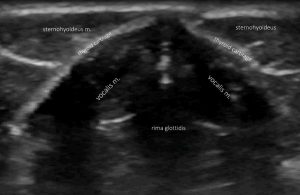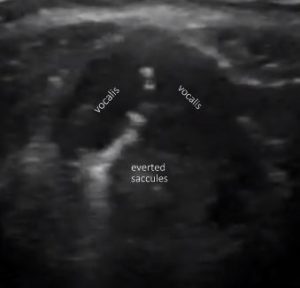Ultrasonographic diagnosis of everted laryngeal saccules in the dog
This is really quite a useful thing to be able to do. Imagine you’re presented with a dog, maybe of the brachycephalic variety, with markedly increased upper respiratory noise. OK you could anaesthetise it and examine the pharynx and larynx; but this is not going to be without risk and, ideally, you want to be prepared to do something therapeutic once you have the dog anaesthetised. So, if you’re not set up to resect everted saccules and perform staphylectomy…or, more importantly, to provide 24 care afterwards in the event of complications, then I’d suggest that you might want to reconsider.
On the other hand you don’t necessarily want to ship every snoring dog off to specialist surgeons straight away. But you can scan the larynx.
This works best with a decent machine and a linear probe. This is a normal dog’s larynx as seen from ventral in a transverse plane:

Transverse plane view of the larynx in a healthy dog. Note the inability to see anything beyond the dorsal surface of the vocalis muscles: the rima glottidis is normally an air-filled space.
And in motion, the vocal cords should obviously move symmetrically:
Now, for comparison, a Chihuahua with endoscopically-confirmed laryngeal saccule eversion:
The saccules appear as a hypoechoic ‘blob’ dorsal to the vocalis muscles. The rima glottidis is reduced to a hyperechoic slit between these structures.






